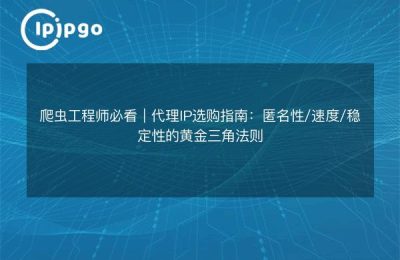
Python Crawler and IP Proxy Pool: Building an Efficient Web Crawler Tool
In the process of web data acquisition, IP proxy pool is a crucial technology that can help the crawler program remain efficient and stable in the face of anti-crawler mechanism. Combining Python crawler technology and IP proxy pool, we can build a powerful web crawler to make data acquisition more efficient and convenient.
Introduction to Python crawler technology
Python, as a concise and powerful programming language, is widely used for web crawler development. With the help of Python's various libraries and frameworks, developers can quickly write crawlers to crawl, parse, and store web content.With the advantages of flexibility and a low learning curve, Python crawler technology is the tool of choice for many data crawling projects.
The Role of IP Proxy Pools
IP Proxy Pool is a system that dynamically manages proxy IPs and can automatically detect the availability of proxy IPs and provide them to the crawler program. By using IP proxy pool, the crawler program can easily change the IP to avoid being blocked by the website ip and improve the crawling efficiency.The role of IP proxy pool is to provide stable and efficient proxy IP resources for the crawler program.
Python Crawler with IP Proxy Pooling
Combining Python crawler technology and IP proxy pool can realize more efficient and stable web data acquisition. In the crawler program, we can get the available proxy IP by calling the interface of IP proxy pool, and then use the proxy IP to access the web page when requesting. In this way, the crawler program can circumvent the anti-crawler mechanism and maintain a stable data acquisition speed.
Steps to build an IP proxy pool
Building an IP proxy pool typically includes the following steps:
1. Obtaining Proxy IP Resources: You can obtain proxy IP resources through purchase or free of charge.
2. Verify Proxy IP availability: Write a program to verify proxy IPs and filter out available proxy IPs.
3. Build IP Proxy Pool: Store available proxy IPs into a database or cache and make them available to the crawler program.
4. Use IP proxy pool in the crawler program: Integrate the call logic of IP proxy pool in the crawler program to realize the dynamic switching of proxy IP.
concluding remarks
The combination of Python crawler technology and IP proxy pool provides powerful support for web data acquisition. Through the reasonable use of IP proxy pool, we can build an efficient and stable web crawler program to achieve rapid crawling and analysis of various website data. Let's fully utilize the advantages of Python crawler technology and IP proxy pool to develop more powerful web crawler tools and explore a wider world of data.








